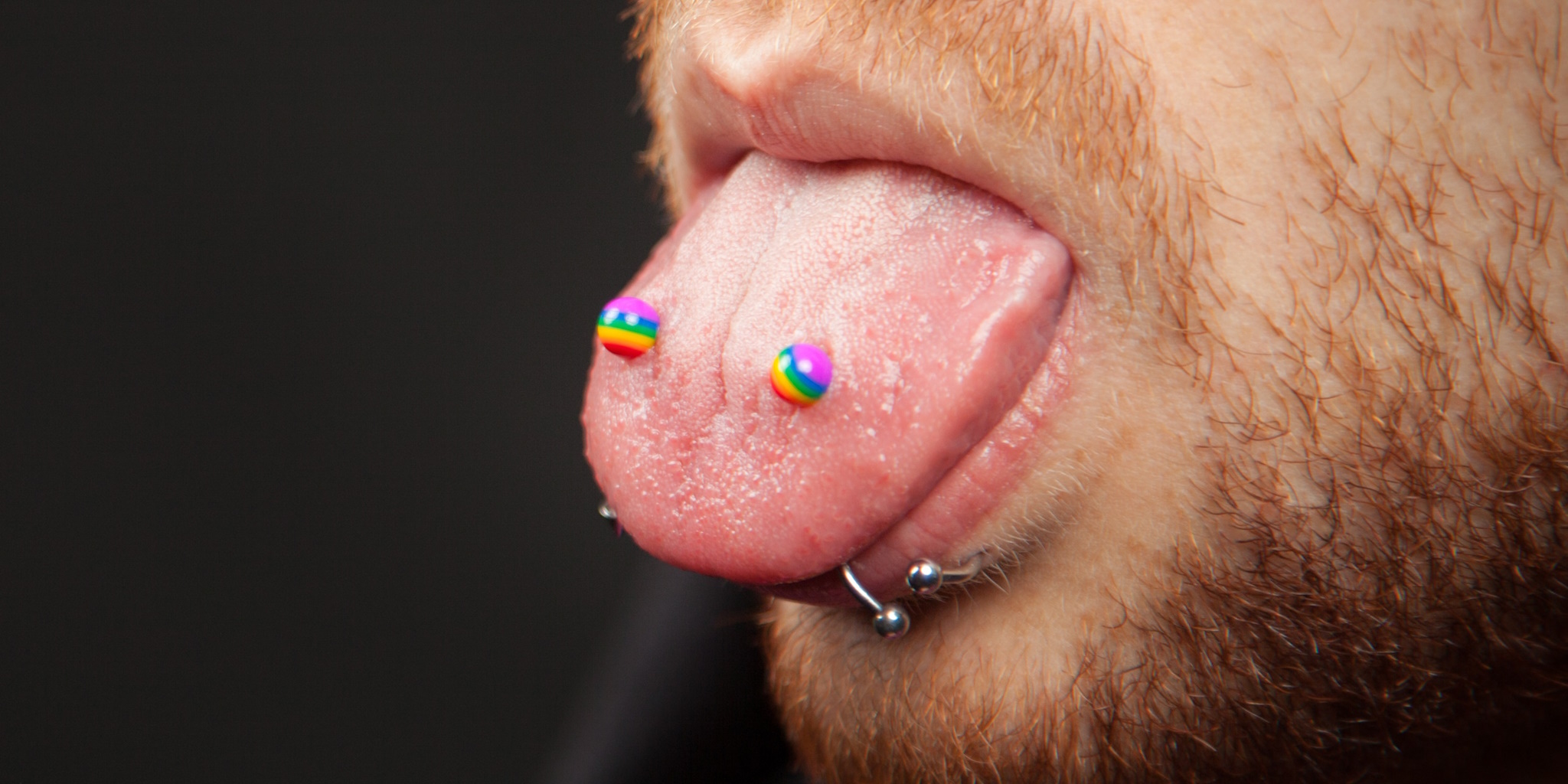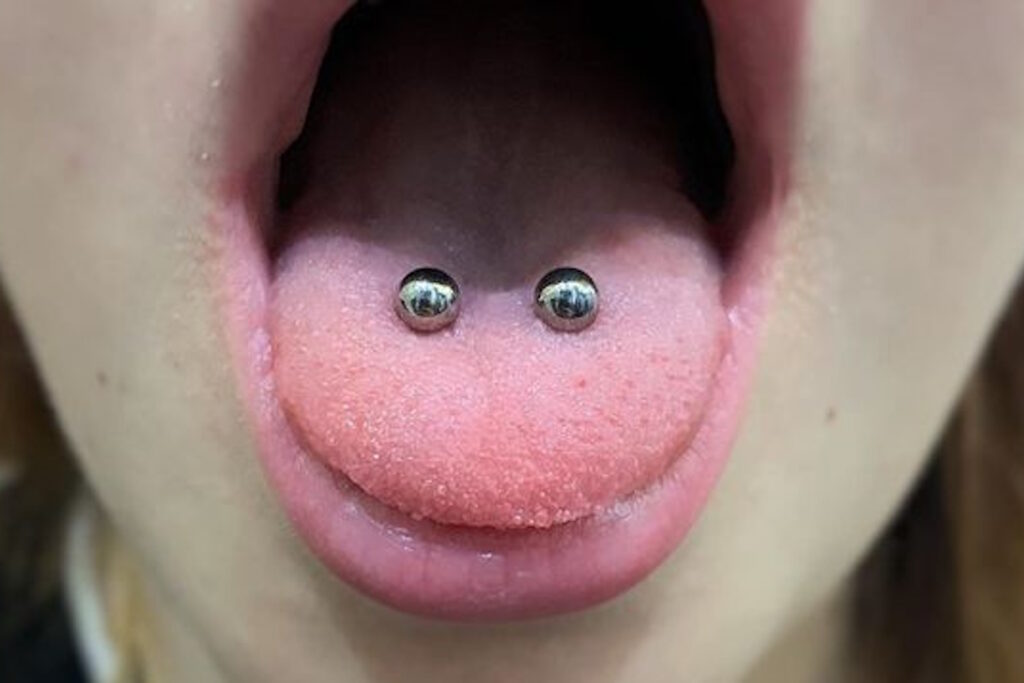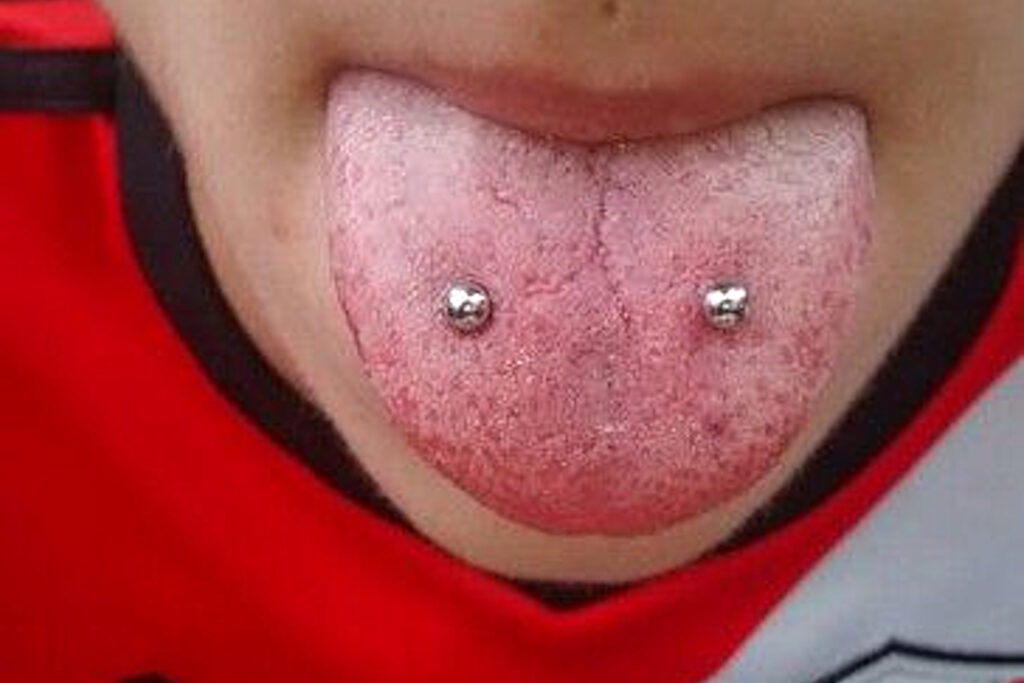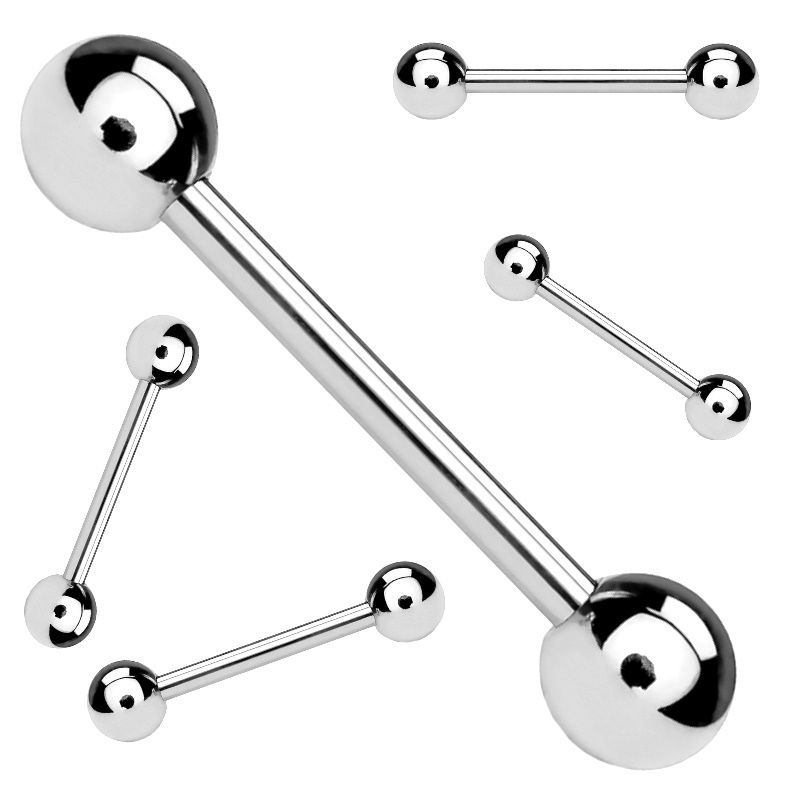
Frog Eyes Piercing: A New Trend Leaping Into The Spotlight
Frog Eyes Piercing Article Quick Reference:
History | Myths | Complications | Pain | Cost | Procedure | Healing | Aftercare | Jewelry | Celebrities
In the ever-evolving world of body art, the frog eyes piercing has made a remarkable splash. What’s the history behind this intriguing modification? How is the procedure executed, and what can one expect in terms of pain and potential complications? As we delve deeper into this growing trend, we’ll uncover the allure of the frog eyes piercing and offer essential insights for those considering taking the leap themselves.
Deriving its whimsical name from the appearance of a frog’s bulbous eyes, this piercing sees two studs placed vertically side-by-side through the tongue, mirroring the amphibian’s iconic gaze on the top of the tongue. See the diagram below for a visual idea of the frog eyes piercing.

A FROG EYES HISTORY
The frog eyes tongue piercing, while enjoying a surge in popularity in recent years, is not an entirely new phenomenon. The history of tongue piercings themselves spans thousands of years, with ancient civilizations like the Aztecs and Maya engaging in the practice for spiritual and ritualistic reasons. Over time, tongue piercings have taken various forms and have been embraced by different subcultures across the world.
The specific “Frog Eyes” style, however, has its origins in the late 20th to early 21st century. As body modification communities began to experiment with various placements and styles, the idea of having dual horizontal piercings on the tongue’s surface became appealing to many. The term “Frog Eyes” was coined due to the uncanny resemblance of the side-by-side studs to a frog’s protruding eyes.
This style initially gained traction within certain subcultural circles, particularly those that were more heavily invested in pushing the boundaries of traditional body modification. It’s worth noting that while many other piercings have clear records of their origins and historical significance, the frog eyes piercing’s history is more nebulous, largely owing to its recent emergence and the decentralized nature of modern body modification trends.
As with many piercing trends, celebrity influence, social media, and evolving societal perceptions of body art have propelled the frog eyes piercing into greater visibility. Today, it stands not just as an expression of individuality, but also as a nod to the ever-changing tapestry of body modification history.
FROG EYES PIERCING MYTHS
Frog eyes tongue piercing, with its captivating appearance, has not only attracted a multitude of enthusiasts but has also been shrouded in myths and misconceptions. Here, we will debunk some of the most common myths associated with frog eyes piercings and shed light on the truths behind them. See them below:
- Instant Speech Impediment: Many believe that getting a frog eyes piercing will immediately cause a speech impediment. While some might experience temporary changes in speech, it’s usually temporary as one gets used to the piercing.
- Eating Is Impossible Post-Piercing: Some think that after the piercing, they won’t be able to eat normally for weeks. In reality, while there might be some discomfort initially, most people adapt quickly and return to their normal eating habits within a few days.
- Tongue Splitting Risk: There’s a misconception that the dual piercings might cause the tongue to split in two. With proper placement and care, this risk is minimal.
- Constant Pain: The belief that the piercing results in ongoing, constant pain is a myth. While there’s initial pain from the piercing itself and some discomfort during the healing process, continuous pain is not a common experience.
- High Rejection Rate: A common misconception is that the tongue, due to its constant movement, will reject the frog eyes piercings more frequently than other piercings. In fact, with proper care and placement, the rejection rate is not significantly higher than other common piercings.
- Permanent Taste Loss: Some are under the impression that the piercing can lead to a loss of taste. The tongue’s taste buds are not permanently affected by this piercing when done correctly.
Remember, like all myths, these often stem from misinformation or isolated incidents. It’s always best to consult with a professional piercer to understand the true risks and benefits of any piercing.
WHO LIKES THE FROG EYES PIERCING BEST?
The frog eyes piercing, like many body modifications, does not strictly adhere to a particular age or gender demographic. However, certain trends can be observed:
- Age: The piercing is generally more popular among the younger demographic, specifically those aged between 18 and 30. This age range typically encompasses individuals who are more open to experimenting with their appearance and trying out bolder body modifications. It’s worth noting that many professional piercing parlors require customers to be at least 18 years old or have parental consent if they’re below this age, for tongue piercings due to the invasive nature and potential complications associated with oral piercings.
- Gender: While body modifications transcend gender boundaries, and individuals of all genders embrace them, certain piercings might see a slight skew towards one gender over others due to societal norms or trends. The frog eyes tongue piercing does not show a significant gender preference; it was adopted by individuals across the gender spectrum.
That being said, trends in body modification, like in fashion and other aesthetic choices, evolve over time. Local culture, celebrity influence, and other factors can also impact the popularity of specific piercings among different demographics.
WHAT ARE THE RISKS?
The frog eyes tongue piercing, while a unique and stylish body modification, is not without its risks. Like all piercings, it’s essential to be well-informed about potential complications and necessary precautions before committing. Let’s delve into the specific risks associated with this piercing. Here are some risks and complications of a frog eyes piercing:
- Infection: The mouth is full of bacteria, and an improperly cared-for piercing can lead to infections.
- Swelling: The tongue usually swells significantly after piercing, affecting speech and eating.
- Prolonged Bleeding: Piercing the tongue carries the risk of prolonged bleeding if it pierces a blood vessel.
- Migration And Rejection: The body might push the jewelry to the surface, causing migration or complete rejection.
- Gum And Tooth Damage: The metal jewelry can potentially chip or crack teeth and wear down gum tissue.
- Aspiration Or Ingestion Hazards: Loose or poorly secured jewelry can become dislodged and pose a risk of inhalation or swallowing, potentially requiring medical intervention.
- Difficulty In Speaking And Eating: At least initially, many people face challenges while speaking or eating.
- Nerve Damage: If done incorrectly, there’s a risk of nerve damage which might affect sensation or movement.
- Allergic Reaction: Some might be allergic to the metal used in the jewelry.
WHAT ARE THE COMPLICATIONS?
Not only should you consider these risks, but also you want to take any of your current health conditions into consideration before getting a frog eyes tongue piercing. Consider these below:
- Oral Health: Ensure your teeth and gums are in good health. If you have pre-existing oral health issues, consult a dentist beforehand.
- Medications: Some medications, especially blood thinners including taking regular aspirin, can increase the risk of prolonged bleeding.
- Immune System: Those with compromised immune systems might be at a higher risk for infections. These include diseases such as HIV/AIDS and Lupus.
- Previous Oral Surgeries: If you’ve had oral surgeries or have structural anomalies in your tongue, consult with a professional piercer and possibly a healthcare provider.
- Lifestyle: Consider any lifestyle factors like regular sports activities, which might increase the risk of injury or complications.
Knowledge is power. Being aware of these risks and considerations ensures you can make a well-informed decision about any body modification.

I DON’T WANT MY FROG EYES PIERCING ANYMORE. WHAT SHOULD I DO?
You can reverse a frog eyes tongue piercing by simply removing the jewelry. However, how the piercing heals and whether it completely closes up depends on several factors:
- Duration Of Piercing: If the frog eyes piercing is relatively new and the jewelry is removed, the holes will generally close up more quickly. For piercings that have been in place for several years, the holes might shrink but not fully close.
- Individual Healing Rates: Everyone’s body is different. Some people might find that their piercing closes up within hours to days after removing the jewelry, while for others, it might take longer or may not close completely.
- Tissue Damage: If there’s been any tissue damage or if scar tissue has formed, the piercing might not close up entirely, leaving a small indent or mark where the jewelry used to be.
- Infection History: If the piercing was ever infected and not treated promptly, it could affect how well and how quickly the piercing heals once the jewelry is removed.
In general, the tongue is known to heal relatively quickly compared to other body parts. If you’re considering removing your frog eyes tongue piercing and are concerned about the healing process, it’s a good idea to consult with a professional piercer. They can provide guidance tailored to your specific situation and offer tips for promoting healing.
WHAT ABOUT THE FROG EYES PIERCING PAIN?
The pain experienced during any piercing is subjective and can vary significantly from person to person. However, when it comes to the frog eyes tongue piercing, many report that it’s somewhat comparable to other tongue piercings. The tongue is a muscle with numerous nerve endings, so there’s often a sharp, brief pain when the needle passes through. Get an idea of just how painful is the frog eyes piercing below:
- Initial Sharp Sensation: Most people describe the actual piercing process as a quick, sharp sensation.
- Post-Piercing Sensation: After the piercing, the tongue might swell and be tender for several days, potentially causing more discomfort than the actual piercing process.
- Comparative Pain: Many find the tongue piercing to be less painful than they anticipated, especially when compared to cartilage piercings. However, this is subjective.
Here are some ways to make the piercing more comfortable:
- Stay Calm: Being anxious can heighten pain sensitivity. Techniques like deep breathing or bringing a friend for support can help keep you calm.
- Avoid Blood-Thinners: Avoid consuming alcohol or caffeine before the piercing as they can thin the blood and lead to excessive bleeding. This also means avoiding aspirin.
- Eat Beforehand: Having a meal before the piercing can help stabilize your blood sugar levels, preventing dizziness or fainting.
- Ice: After the piercing, sucking on small ice chips can help reduce swelling and numb the area slightly, providing relief.
- Non-Prescription Pain Relievers: Over-the-counter pain relievers like ibuprofen can be taken to reduce swelling and pain, but it’s essential to ensure they don’t have blood-thinning properties. Always consult with a healthcare professional before taking any medication.
Remember, everyone’s pain threshold is different. What might be a minor discomfort for one person might be more painful for another.

HOW MUCH WILL A FROG EYES PIERCING SET ME BACK?
The cost of a frog eyes tongue piercing can vary based on several factors, including the region, city, reputation of the piercing studio, experience of the piercer, and the type of jewelry chosen. Here’s a general range of costs for tongue piercings across different regions of the U.S. Please note that these are general estimates, and prices can fluctuate based on the aforementioned factors. It’s always best to check directly with local studios for the most current prices.
- East Coast: Including cities like New York City, NY; Boston, MA; Miami, FL; and Washington, DC
- Low End: $40 – $60
- High End: $80 – $120
- South: Including cities like Atlanta, GA; Dallas, TX; Nashville, TN; and New Orleans, LA
- Low End: $35 – $55
- High End: $70 – $110
- West Coast: Including cities like Los Angeles, CA; San Francisco, CA; Seattle, WA; and San Diego, CA
- Low End: $50 – $70
- High End: $90 – $130
- Midwest: Including cities like Chicago, IL; Detroit, MI; Minneapolis, MN; and St. Louis, MO.
- Low End: $30 – $50
- High End: $60 – $100
It’s important to remember that cost should not be the only determining factor when getting a piercing. The cleanliness of the studio, the reputation and experience of the piercer, and the quality of the jewelry are crucial elements to consider. Sometimes, paying a bit more for a reputable piercer in a hygienic environment can save you from potential complications and additional costs down the road.
THE FROG EYES PIERCING PROCEDURE
First, a frog eyes tongue piercing is typically done with a 14-gauge needle. This is the standard thickness to minimize risks like tearing or migration.
Here’s a step-by-step breakdown of a typical procedure:
- Consultation: Before the actual piercing, there’s often a consultation where you discuss your desired outcome and potential risks.
- Choosing The Jewelry: You’ll select the type of jewelry you want for the piercing. This usually involves surgical steel barbells, but there may be other options available.
- Preparation: The piercer will ensure the environment is sterile. You’ll then rinse your mouth with an antiseptic mouthwash.
- Marking The Placement: The piercer will use a surgical marker to place dots on your tongue where the piercings will go, ensuring they are symmetrical and properly spaced.
- Clamping: Using a sanitized, specialized clamp (often a Pennington or a straight clamp), the piercer will hold your tongue in place.
- Piercing: The piercer will quickly and carefully push a sterilized, sharp, hollow needle through the marked points on your tongue, usually from top to bottom. The jewelry is then inserted through the hollow of the needle, which is followed by the needle being pulled out, leaving the jewelry in place. The process is then repeated for the second piercing.
- Cleaning And Checking: Once the jewelry is securely in place, the piercer will clean away any blood or marker marks. They will then inspect the piercing.
- Aftercare Instructions: You’ll be provided with detailed aftercare instructions. This usually involves cleaning instructions and things to do and not do while your tongue is healing.
Remember, the key to a successful piercing experience is to go to a reputable and experienced professional, follow their aftercare instructions rigorously, and consult them if any issues arise during the healing process.
ALL ABOUT THE HEALING TIME
The frog eyes tongue piercing involves two separate piercings on the tongue. See the two stages of the healing process below:
- Initial Healing: This is when the surface of the piercing starts to heal. For tongue piercings, the initial healing phase typically lasts anywhere from 4 to 6 weeks. During this period, you may notice the following:
- Swelling: Swelling commonly occurs during the first week, and sucking on ice chips, elevating the head while sleeping, and taking over-the-counter anti-inflammatory medications (as recommended by a healthcare professional) can alleviate it.
- Speech And Eating: These may be challenging initially, so soft foods and avoiding hot or spicy items can help.
- Full Healing: This is when the internal tissue of the piercing heals completely. For tongue piercings, full healing can take anywhere from 4 to 6 months, sometimes longer. It’s worth noting that while the surface might appear healed within the initial healing period, the tissue inside can still be healing.
Hold tight, it will all go by in a flash and you will be free from any residual swelling, pain, and uncomfortable feelings.
FROG EYES PIERCING AFTERCARE
Aftercare for a Frog Eyes Tongue Piercing is crucial to prevent infection, promote speedy healing, and ensure the best possible results. Here’s a breakdown of the recommended aftercare procedures:
Oral Hygiene:
- Non-alcoholic Mouthwash: Use a saline-based or alcohol-free mouthwash after every meal and drink. Alcohol can irritate the piercing, so it’s essential to opt for a gentle formula.
- Salt Water Rinses: Rinse your mouth with a warm saline solution (a mixture of non-iodized sea salt and warm distilled or bottled water) 2-3 times a day.
Swelling Management:
- Ice: Sucking on ice chips or crushed ice can help reduce swelling, especially in the first few days after getting the piercing.
- Anti-Inflammatory Medications: Over-the-counter nonsteroidal anti-inflammatory drugs (NSAIDs), like ibuprofen, can help manage swelling and discomfort. However, always consult a healthcare professional before starting any medication.
Dietary Precautions:
- Soft Foods: Opt for soft foods during the initial healing period to avoid trauma to the piercing.
- Avoid These Foods: Avoid spicy, salty, or hot foods/beverages as they can increase irritation and swelling.
- No Alcohol Or Caffeine: Stay away from alcohol and caffeine during the early healing stages as they can exacerbate swelling.
Avoid Oral Contaminants:
- No Smoking: Do not smoke or use tobacco products as they can delay healing and increase infection risk.
- Do Not Touch: Avoid playing with the piercing using your fingers or teeth.
- No Oral Intacimy Or Sharing: Stay away from activities that might introduce bacteria into your mouth, such as oral intimacy or sharing drinks.
General Precautions:
- Oral Hygiene: Maintain good overall oral hygiene, including regular brushing, but be gentle around the piercing site to avoid trauma.
- Avoid These Products: Do not use products containing alcohol, peroxide, or glycol, as they can hinder the healing process.
- Avoid Dirty Water: Avoid swimming in public pools, hot tubs, or open water during the early healing stages to minimize the risk of bacterial exposure.
Regular Checks:
- Monitor: Monitor the piercing for signs of infection. This includes such things as excessive redness, persistent swelling, yellow or green discharge, or a foul odor. If any of these symptoms are present, consult a healthcare professional or your piercer.
- Check-Ups: It’s also a good idea to visit your piercer for periodic check-ups to ensure the healing is on track.
Remember, each individual’s body is different, and healing times can vary. Listening to your body and adhering to aftercare guidelines can help ensure a smooth healing process for your frog eyes tongue piercing.
SWAPPIN OUT THE STARTER JEWELRY
The frog eyes piercing generally requires some healing time before the initial or “starter” jewelry can be swapped out. Here’s a guide on when and how to go about it:
Timing For Changing The Jewelry
- Initial Swelling: A few days to a week after the piercing, once the initial swelling has subsided, some individuals may need to return to their piercer to swap out the longer barbell (used to accommodate swelling) for a shorter one.
- Complete Healing: For a full jewelry change (like a different style or material), it’s usually recommended to wait until the piercing is entirely healed. This of course can be anywhere from 4 to 6 weeks for the initial healing phase. The internal tissue might take 4 to 6 months or more to fully heal.
Tips For Swapping The Jewelry:
- Get Professional Help: Especially for the first swap, it’s advisable to have the jewelry changed by a professional piercer. They can ensure the piercing is healed enough for the change and can handle the jewelry without causing trauma.
- Clean Hands: If you’re changing the jewelry yourself, always start by washing your hands thoroughly with antibacterial soap.
- New Jewelry: Ensure that the new jewelry is clean and sanitized. It’s a good idea to soak it in a saline solution for a few minutes before insertion.
- Open and Close: If your jewelry has balls or attachments, familiarize yourself with how to open and close it. This is especially crucial for tongue piercings, as you don’t want to accidentally swallow anything.
- Gentle Movement: When removing the old jewelry and inserting the new piece, move slowly and gently. This will minimize damage to the piercing.
- Lubrication: Using a saline solution can help lubricate the piercing, making it easier to insert the new jewelry.
- Aftercare: After changing the jewelry, rinse your mouth with a non-alcoholic mouthwash or saline solution to keep the area clean.
If you feel uncertain about changing the jewelry or encounter resistance when trying to insert the new piece, consult with a professional piercer.
FROG EYES PIERCING JEWELRY MATERIALS
When it comes to frog eyes tongue piercings, selecting the right material and style is essential to ensure safety, comfort, and aesthetic appeal. See the following materials that are best for frog eyes piercing jewelry:
- Implant-Grade Titanium: This is often recommended for fresh piercings because of its hypoallergenic properties. Titanium doesn’t contain nickel, making it an excellent choice for those with sensitivities or allergies.
- Surgical Stainless Steel: Another common material, surgical stainless steel is both durable and less likely to cause allergic reactions, though it may contain some nickel. It’s vital to ensure that the steel is of high quality and appropriate for body jewelry.
- Niobium: This is a non-reactive, hypoallergenic metal that is often used for body jewelry. It’s slightly heavier than titanium but can be anodized into various colors like titanium.
- Solid 14K Gold Or Higher: If opting for gold, ensure it’s solid gold (14K or higher) and not just gold-plated. Gold-plated jewelry can wear down, exposing the underlying metal, which might not be body-safe.
- PTFE (Teflon) Or Bioplast: These are flexible, bio-compatible materials often used for tongue jewelry, especially during the initial healing stages, as they can be more comfortable and cause less wear and tear on the teeth and gums.
Make sure to avoid materials like sterling silver, coated metals, or low-quality alloys for fresh piercings, as they can oxidize or degrade, which may lead to complications.
FROG PIERCING JEWELRY TYPES
Here are some of the best styles of frog eyes piercing jewelry:
- Straight Barbells: The most common choice for tongue piercings, including frog eyes. They consist of a straight bar with balls or other decorative elements on either end.
- Flat-Back Labrets: While less common for tongue piercings, some people opt for these because the flat back can be more comfortable against the bottom of the mouth.
Regardless of the material or style chosen, it’s crucial to ensure the size (length and gauge) is appropriate for your piercing and anatomy. Consulting with a professional piercer can help guide choices that are both safe and stylish.

ARE THERE ANY CELEBRITIES WITH FROG EYES?
The frog eyes piercing is not one of the most popular piercings among celebrities. This could change over time, as trends and preferences evolve. However, many celebrities have had various other piercings, including standard tongue piercings, but the specific “Frog Eyes” style has not been notably popular or widely publicized among mainstream celebrities. To get the most updated list, you might want to check recent articles, gossip columns, or celebrity social media accounts.
FINAL THOUGHTS
The Frog Eyes tongue piercing, while not as mainstream as some other body modifications, offers a unique and daring aesthetic for those seeking to stand out. Its dual placement on the tongue makes it both a statement and a conversation starter.
Like all piercings, it demands diligent aftercare, informed jewelry choices, and a skilled professional for a safe and satisfactory outcome. As with any body art decision, understanding its history, risks, and required maintenance is vital. Embracing this distinctive style can be a bold way to express one’s individuality, but it’s essential to embark on the journey informed and prepared.
Need to find a piercer? Check out the Association of Professional Piercers.
Author: Scott S.

